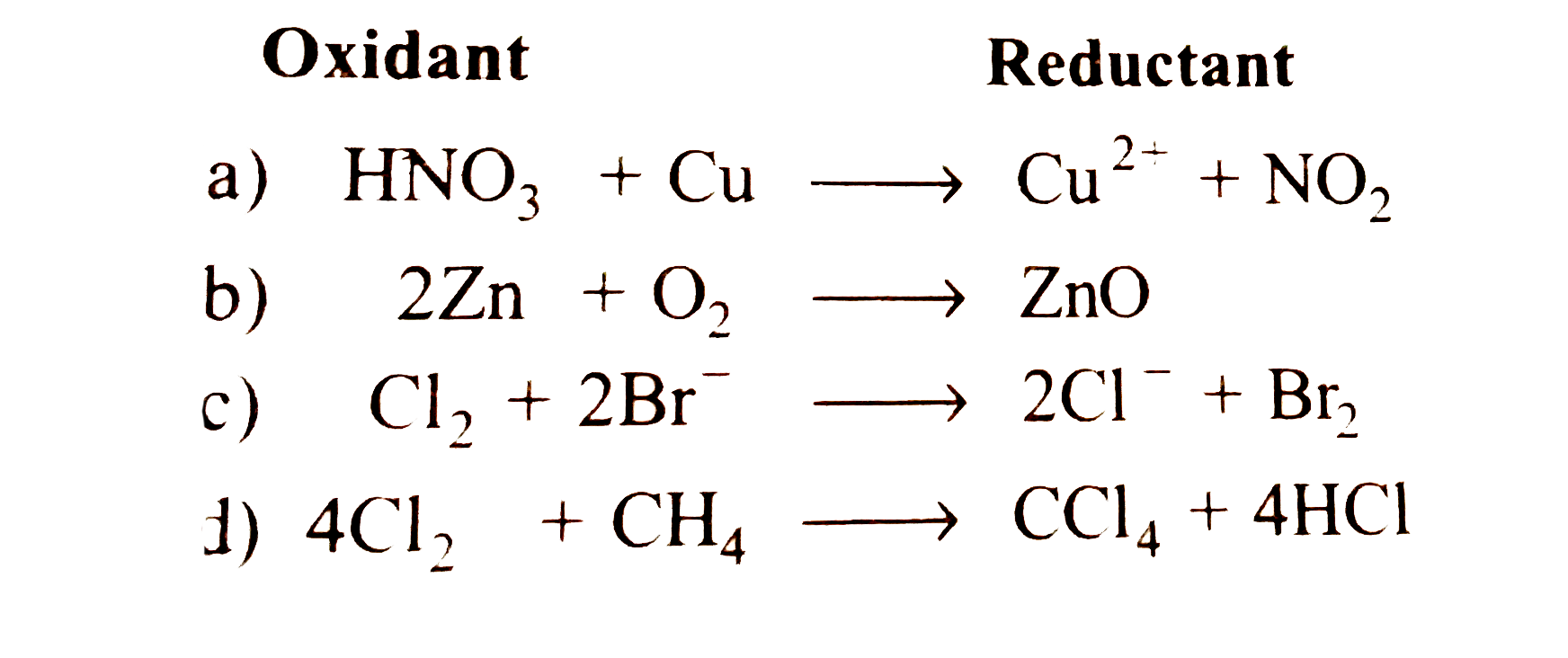Oxidation and reduction process involves the transaction of electrons. Loss of electrons is oxidation and the gain of electrons is reduction. It is thus obvious that in a redox reaction, the oxidant is reduced by accepting the electrons and the reductant is oxidised by losing electrons. The reactions in which a species disproportionates into two oxidation states (lower and higher) are called disproportionation reactions. In electrochemical cells, redox reaction is involved, i.e., oxidation takes place at anode and reduction at cathode.
The reaction is:
oxidation
reduction
disproportionation
neither oxidation nor reduction
The correct Answer is:C
Step by step video, text & image solution for Oxidation and reduction process involves the transaction of electrons. Loss of electrons is oxidation and the gain of electrons is reduction. It is thus obvious that in a redox reaction, the oxidant is reduced by accepting the electrons and the reductant is oxidised by losing electrons. The reactions in which a species disproportionates into two oxidation states (lower and higher) are called disproportionation reactions. In electrochemical cells, redox reaction is involved, i.e., oxidation takes place at anode and reduction at cathode. The reaction Cl_(2)to Cl^(-)+ClO_(3)^(-) is: by Chemistry experts to help you in doubts & scoring excellent marks in Class 11 exams.
Updated on:21/07/2023Topper's Solved these Questions
- OXIDATION AND REDUCTION (REDOX REACTIONS)Book:OP TANDONChapter:OXIDATION AND REDUCTION (REDOX REACTIONS)Exercise:Self assignment
Explore 22 Videos
- OXIDATION AND REDUCTION (REDOX REACTIONS)Book:OP TANDONChapter:OXIDATION AND REDUCTION (REDOX REACTIONS)Exercise:SECTION V
Explore 3 Videos
- OXIDATION AND REDUCTION (REDOX REACTIONS)Book:OP TANDONChapter:OXIDATION AND REDUCTION (REDOX REACTIONS)Exercise:INTEGER TYPE
Explore 11 Videos
- MISCELLANEOUS (TOPICS OF GENERAL INTEREST)Book:OP TANDONChapter:MISCELLANEOUS (TOPICS OF GENERAL INTEREST)Exercise:SET-VI: Problems on graphical aptitude
Explore 53 Videos
- POLYMERSBook:OP TANDONChapter:POLYMERSExercise:PASSAGE 3
Explore 5 Videos
Similar Questions
Oxidation and Reduction Reactions
View SolutionOxidation and reduction process involves the transaction of electrons. Loss of electrons is oxidation and the gain of electrons is reduction. It is thus obvious that in a redox reaction, the oxidant is reduced by accepting the electrons and the reductant is oxidised by losing electrons. The reactions in which a species disproportionates into two oxidation states (lower and higher) are called disproportionation reactions. In electrochemical cells, redox reaction is involved, i.e., oxidation takes place at anode and reduction at cathode.
Detennine the change in oxidation number of sulphur in H2SandSO2 respectively in the following reaction:
2H2S+SO2→2H2O+3S
View Solution
Knowledge Check
Oxidation and reduction process involves the transaction of electrons. Loss of electrons is oxidation and the gain of electrons is reduction. It is thus obvious that in a redox reaction, the oxidant is reduced by accepting the electrons and the reductant is oxidised by losing electrons. The reactions in which a species disproportionates into two oxidation states (lower and higher) are called disproportionation reactions. In electrochemical cells, redox reaction is involved, i.e., oxidation takes place at anode and reduction at cathode.
Select the correct statement:Aoxidation takes place at anode in electrochemical cellBreduction take place at anode in electrolytic cellCoxidation takes place at anode n electrolytic cellDall are correctOxidation and reduction process involves the transaction of electrons. Loss of electrons is oxidation and the gain of electrons is reduction. It is thus obvious that in a redox reaction, the oxidant is reduced by accepting the electrons and the reductant is oxidised by losing electrons. The reactions in which a species disproportionates into two oxidation states (lower and higher) are called disproportionation reactions. In electrochemical cells, redox reaction is involved, i.e., oxidation takes place at anode and reduction at cathode.
In the reaction:
I2+2S2O2−3→2I−+S4O2−6AI2 is a reducing agentBI2 is an oxidising agentCS2O2−3 is a reducing agentDS2O2−3 is an oxidising agentOxidation and reduction process involves the transaction of electrons. Loss of electrons is oxidation and the gain of electrons is reduction. It is thus obvious that in a redox reaction, the oxidant is reduced by accepting the electrons and the reductant is oxidised by losing electrons. The reactions in which a species disproportionates into two oxidation states (lower and higher) are called disproportionation reactions. In electrochemical cells, redox reaction is involved, i.e., oxidation takes place at anode and reduction at cathode.
Which of the following reactions is/are correctly indicated?
 AHNO3+Cu→Cu2++NO2B2Zn+O2→ZnOCCl2+2Br−→2Cl−+Br2D4Cl2+CH4→CCl4+4HCl
AHNO3+Cu→Cu2++NO2B2Zn+O2→ZnOCCl2+2Br−→2Cl−+Br2D4Cl2+CH4→CCl4+4HCl
Oxidation reaction involves loss of electrons, and reduction reaction involves gain of electrons. The reaction in which a species disproportinates into two oxidation states ( lower and higher) is called disproportionation reaction.
Which of the following statements is wrong?
View SolutionOxidation reaction involves loss of electrons, and reduction reaction involves gain of electrons. The reaction in which a species disproportinates into two oxidation states ( lower and higher) is called disproportionation reaction.
Which of the following statements is wrong?
View SolutionOxidation reaction involves loss of electrons, and reduction reaction involves gain of electrons. The reaction in which a species disproportinates into two oxidation states ( lower and higher) is called disproportionation reaction.
Which of the following statements is wrong?
View SolutionOxidation reaction involves loss of electrons, and reduction reaction involves gain of electrons. The reaction in which a species disproportinates into two oxidation states ( lower and higher) is called disproportionation reaction.
Which of the following statements is correct?
View SolutionOxidation reaction involves loss of electrons, and reduction reaction involves gain of electrons. The reaction in which a species disproportinates into two oxidation states ( lower and higher) is called disproportionation reaction.
Which of the following is not a dispropotional reaction?
View Solution
